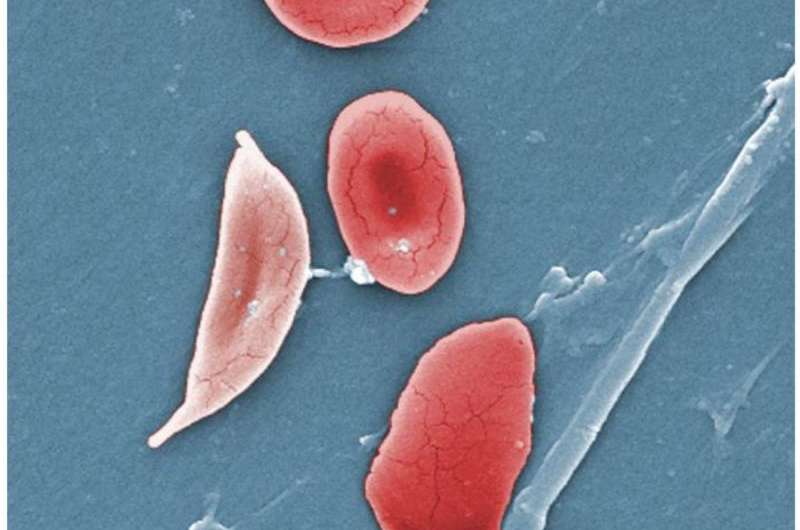This article has been reviewed according to Science X's editorial process and policies. Editors have highlighted the following attributes while ensuring the content's credibility:
fact-checked
peer-reviewed publication
trusted source
proofread
International trial introduces another curative option for sickle cell disease

Vanderbilt University Medical Center (VUMC) researchers are touting data from a multicenter, international Phase II clinical trial showing a new, curative treatment for sickle cell disease (SCD).
The therapy, nonmyeloablative haploidentical bone marrow transplant (BMT) with thiotepa and posttransplant cyclophosphamide (PTCy), is proving to have equivalent efficacy and one-fifth the cost as recently FDA-approved myeloablative gene therapy options, according to Michael DeBaun, MD, MPH, director of the Vanderbilt-Meharry Center of Excellence in Sickle Cell Disease.
Results from the 10-year trial, published June 20 in the journal Blood, show a two-year overall survival of 94.1% with no difference between children and adults.
DeBaun and Adetola Kassim, MD, professor of Medicine and clinical director of the Adult Stem Cell Transplant Program at VUMC, led the international trial that included 32 children and 38 adults from five countries.
The team developed the protocol for the newest treatment.
"We are introducing another curative option for SCD treatment that is just as safe and more affordable than the recently FDA-approved myeloablative gene therapy and gene editing trials," said DeBaun, vice chair of Clinical Research and professor of Pediatrics at Monroe Carell Jr. Children's Hospital at Vanderbilt.
"It's imperative that physicians and families are aware of our findings so that they can make decisions about the best personalized curative therapy option.
"One of the most significant advantages of our curative therapy approach—most transplant centers in the United States and the world can provide this life-sustaining treatment tomorrow because they are very familiar with the now routine haploidentical transplant protocol with PTCy."
Until now, there were few curative options presented to adults with SCD because of the few full-matched donors and the ability of most adults with SCD to tolerate myeloablative treatment before transplant.
The haploidentical transplant protocol only requires a half match, which can be from the mother, father, siblings, and even children, and is nonmyeloablative, an approach that typically preserves fertility.
In the recently completed trial, 90% of the potential participants had an available donor, according to study investigators, greatly improving access to lifesaving therapy.
"The results also show that this approach was well tolerated in older adults with SCD, who otherwise had been excluded from prior approaches with hematopoietic stem cell transplants due to the inherent toxicity of the prior regimen in a population with significant disease burden," Kassim said.
Other study findings revealed 96% of participants were off immunosuppression one year after transplant. The overall two-year survival rate was approximately 95% in children and adults, similar to the results in most SCD curative trials.
All eight graft failures (where the donor's cells did not continue to grow in the recipient) occurred in the children; however, the children's bone marrow recovered completely after the transplant and did not require additional treatment.
Further research is being done to improve the donor's bone marrow engraftment in children. At the same time, adults do not need further refinement in their protocol.
"We still need to understand the late health effects of all SCD curative therapies," DeBaun said. "Ultimately, we believe the late health effects of the different types of curative therapy will help families make an informed decision about which type of therapy they want."
The second curative therapy options, approved by the Food and Drug Administration in 2023, consist of myeloablative gene editing and gene therapy treatments, which cost between $2 million and $3 million, respectively.
DeBaun said the biggest takeaways from the study include:
- The haploidentical protocol is readily available for children and adults with SCD living in middle- and high-income countries because haploidentical transplant protocol is routine in most locations.
- Two-year cure rates and overall survival rates are at least as good as those for the gene therapy and gene editing trials.
DeBaun noted that he and Kassim were two of four co-chairs for the multicenter trial in the Bone Marrow Transplant-Clinical Trial Network (BMT-CTN 1507) that was presented at the American Society of Hematology Conference in 2023.
"The now-closed NIH BMT-CTN 1507 trial is a derivative of the Vanderbilt Consortium. In this trial, the 42 adults had almost the same two-year survival as the Vanderbilt Global Consortium results. The combined results of the two trials with 80 adults demonstrate an outstanding two-year overall survival for adults cured of SCD," DeBaun said.
"We, the Vanderbilt Consortium members and the participants in the trial, have provided an additional curative treatment option for curative therapy for 90% of children and adults with SCD, and the real possibility of global expansion for curing SCD as long as there is a preexisting bone marrow transplant program," he said.
More information: Adetola A. Kassim et al, An international learning collaborative phase 2 trial for haploidentical bone marrow transplant in sickle cell disease, Blood (2024). DOI: 10.1182/blood.2023023301
















